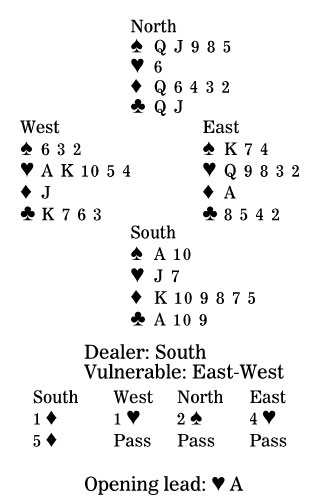A fit-showing jump is a two-in-one bid
By Phillip Alder ( China Daily ) Updated: 2014-10-18 05:59:29Mark Twain wrote, "His money is twice tainted: 'taint yours and 'taint mine."
'Taint that just the case!
It is great to get twice the money for one piece of work. At the bridge table, as we saw yesterday, that is sometimes possible in the bidding. I pointed out that a jump-shift response by a passed hand is fit-showing: length in that suit and partner's suit.
That was in an uncontested auction. When the opponents sail in, I like to use fit-jumps even by an unpassed hand. I jump as high as I am willing to drive the auction.
In this deal, after South opens one diamond and West overcalls one heart, North jumps to two spades, showing a limited hand with five spades and four-plus diamonds. (With a stronger hand, North could jump to three spades.) The auction then proceeds to five diamonds by South.
West leads the heart ace and shifts to his trump. East wins and plays a club. How should South continue after guessing well to win with his club ace?
Declarer needs three dummy entries: one to take the spade finesse, one to ruff out East's spade king, and one to reach the established spade winners. Those entries are a heart ruff, the diamond queen and the diamond six - did you see the necessity for South not to play his diamond five at trick two? Then you can bring home the contract with four spades, five diamonds, one club and the heart ruff.
Note that if North initially responds one spade, East would jump to four hearts and leave both North and South wondering what to do.

|
|
|
|
|
|
|
|

























 Raymond Zhou:
Raymond Zhou: Pauline D Loh:
Pauline D Loh: Hot Pot
Hot Pot Eco China
Eco China China Dream
China Dream China Face
China Face






